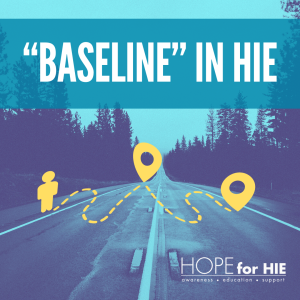
Hypoxic-ischemic encephalopathy (HIE) is a condition that affects infants and children with many causes due to reduced oxygen supply before, during or after birth, and in childhood, leading to potential neurological challenges.
One crucial aspect of managing HIE in children is understanding their baseline, which refers to their typical level of functioning or development. This concept plays an important role in assessing progress, setting goals, and guiding interventions to support their journey to reach their unique potential.

Baseline refers to the level of functioning, skills, and abilities that a child typically demonstrates in various domains such as motor, cognitive, communication, and social-emotional development. In children with HIE, the baseline may be impacted due to the neurological consequences of HIE. These consequences can vary widely depending on the severity of the HIE, the extent of brain injury, and individual differences in resilience, recovery, and development
It’s essential to recognize that each child is unique, and their baseline may differ significantly from that of other children, even those with the same diagnosis. Factors such as prematurity, comorbidities, and the timing and effectiveness of medical interventions can also influence a child’s baseline and recovery trajectory.
The journey for children with HIE to return to their typical baseline can vary considerably, especially after hospitalization. Some children may show rapid progress and reach their baseline within a few months, while others may require more time and intensive interventions to achieve similar outcomes. Factors that can influence the time to return to baseline include:
Navigating the journey towards returning to baseline for children with HIE after hospitalizations, surgeries, or other medical complications, can present various challenges for families, healthcare providers, and caregivers. These challenges may include emotional distress, financial burdens, access to specialized care, and uncertainty about the future. It’s essential for families to seek support from a multidisciplinary team comprising pediatricians, neurologists, developmental specialists, therapists, and support groups to address these challenges effectively.
Many parents share their concerns after hospitalizations, surgery or other medical complications that they are unsure if they have to define a “new normal”, or if their child will return to their previous health status, or an improved one. Know that you aren’t alone in this, regardless of what your child’s health status may be and what their trajectory may be. It’s important that parents AND providers understand that recovery looks different in timing for every person!
There are some children with HIE who will have declines in their overall health and require additional interventions, discussions about quality of life, require additional specialists, or even the involvement of palliative care or transition to hospice. For those cases, we recommend tapping into the Courageous Parents Network resources. They have a whole section on understanding baseline when it comes to managing quality of life and decline, as well as a module about severe, life-limiting neuro journeys. Know that this is NOT everyone’s trajectory with a more severely impacted child with HIE, and many go on to live long, healthy lives.
Connect with families, read inspiring stories, and get helpful resources delivered right to your inbox.